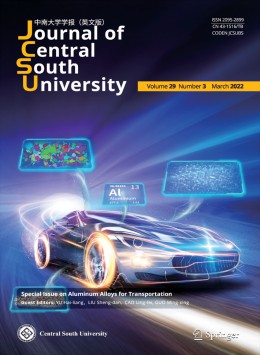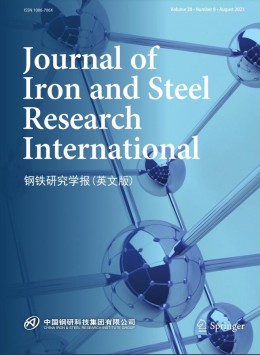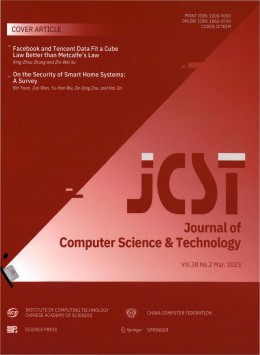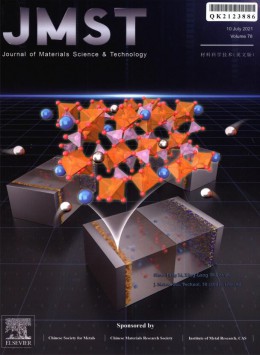
Journal of Central South University雜志SCI期刊CSCD期刊統計源期刊
Journal of Central South University
同學科期刊級別分類 CSSCI南大期刊 北大期刊 CSCD期刊 統計源期刊 部級期刊 省級期刊
- 月刊 出版周期
- 43-1516 / TB CN
- 2095-2899 ISSN
- 主管單位:中國教育部
- 主辦單位:中南大學
- 郵發代號:42-10
- 創刊時間:1994
- 開本:A4
- 出版地:湖南
- 語種:英語
- 審稿周期:1-3個月
- 影響因子:0.68
- 被引次數:294
- 數據庫收錄:
CSCD 中國科學引文數據庫來源期刊(含擴展版)、統計源期刊(中國科技論文優秀期刊)、知網收錄(中)、維普收錄(中)、萬方收錄(中)、EI 工程索引(美)、CA 化學文摘(美)、SA 科學文摘(英)、SCI 科學引文索引(美)、JST 日本科學技術振興機構數據庫(日)、國家圖書館館藏、上海圖書館館藏
Journal of Central South University雜志簡介
《Journal of Central South University》 (formerly named Journal of Central South University of Technology, ) is a comprehensive academic English journal, administrated by the Ministry of Education of China, sponsored by Central South University, and jointly published by Central South University and Springer. It was founded in November 1994, published semi-yearly in 1995-1999, quarterly in 2000-2004, bimonthly in 2005-2011, and will be published monthly from 2012.
《Journal of Central South University》is mainly devoted to publishing academic papers and reports that are of creativeness and present the latest achievement of scientific research in such fields as geology, mining, metallurgy, materials, chemistry and chemical engineering, mechatronics, information, construction, traffic, transportation and environment. The columns of the Journal include: Materials Science and Engineering, Metallurgy, Chemistry and Chemical Engineering; Mechanical Engineering, Control Science and Information Engineering; Energy and Power Engineering, Environmental Engineering and Mine Engineering; Engineering; Geological Engineering, Civil Engineering, Traffic and Transportation Engineering.
《Journal of Central South University》is covered by several famous information retrieval systems and databases, including SCI Expanded, EI Compendex, Chemical Abstracts, Metal Abstracts, Aluminium Industry Abstracts, INSPEC, CSAC, CNKI and WANGFANG DATA. The Journal was consecutively awarded “The High-quality Scientific Journal in Chinese Universities” by the Ministry of Education of China in 2006, 2008 and 2010. Now, the Journal is in its quickly-developing period both in quality and quantity, and has become one of the most influential English journals in China.
《Journal of Central South University》的獲獎情況:2006、2008、2010“中國高校精品科技期刊”;2009“全國高校科技期刊優秀編輯質量獎”;2012中國最具國際影響力學術期刊;2012年入選教育部“精品科技期刊”工程。
Journal of Central South University雜志欄目設置
地采選冶、材料科學術工程、機電與信息工程
Journal of Central South University雜志榮譽信息
Journal of Central South University雜志訂閱方式
地址:Editorial Office of Journal of Central South University Central South University, Changsha 410083, China,郵編:410083。
Journal of Central South University雜志社投稿須知
1.Manuscript preparation Manuscript should be in English and typed on only one side of A4 paper with double space. In addition, a manuscript disk (based on Word) that contains the material to be considered for publication and a copy of the full-length paper is sent to: Editorial Office of Journal of Central South University, Changsha, Hunan, 410083, China. The electronic manuscript can also be sent to the editorial board by E-mail: jcsu@csu.edu.cn.Title and By-line The title should be descriptive, not full sentences. Name, affiliation (institution) of the authors, city, country, E-mail address and telephone number of the author(s) should be listed.
2.Abstract and Key words The abstract of about 100-150 words must accompany each article on page one. It should be self-contained and should be adequate as a summary of the article, namely, it should contain aim and significance, experimental methods and main results and conclusions as well; newly developed conceptions, methods, apparatus, techniques, and newly discovered facts. Summarized results should be exact, direct, and specific.Together with the title, it must be adequate as an index to all the subjects treated in the paper, and will be used as a base for indexing. Avoid displayed mathematical expressions. Define all nonstandard symbols and abbreviations. The key words should include 3-8 pieces of words or phrases to serve as guidelines for indexing, which should be typed below the abstract.
3.Text The text should contain an Introduction that puts the paper into perspective for readers, and should also contain Methods, Results, Discussion and Conclusions. The SI system should be used for units of measure throughout the text. Each Equation or Formula in the article should be numbered in the order with Arabic numerals placed on the right-hand margin. Each caption should be written as a single brief paragraph without indentation. Figures and tables should be consecutively numbered with Arabic numerals. Tables should be drawn with three horizontal lines, at the top and bottom of the table and between the column headings and the table body. Good quality figures have the following characteristics. They should be produced with a good quality laser printer and have lines, letters, numbers and symbols of uniform strength and contrast.
4.Figures Figures (except photographs) are often reduced to 7 cm×7 cm. The final thickness of a line in a figure usually lies within the range 0.15-0.20 mm. When preparing the figures, authors should pay attention to the widths of lines and similar details, as some (e.g. dotted or thin lines) may disappear after reduction. Particular attention should be paid to line strengths in graphics prepared in vector formats.
5.Equations Equations should be neatly typed or clearly written in ink, punctured and aligned to bring out their structure, and numbered on the right. Physical quantities should be printed in italics, and vectors in bold-face italics. For mathematical expressions, the solidus (/) should be used instead of built-up fractions in running text and in display wherever clarity would not be jeopardized. Use “exp” for complicated exponentials.
6.Photographs Photographs should have high contrast. They should be glossy, properly focused and exposed. Those who wish to place two or more photographs side by side are reminded that the column width of this journal is approximately 150 mm. Line drawings should be clear and well designed. The lettering and plotted points should be large enough to be legible after reduction. Graphs should have axes with proper labels such as T/K.
7.Mathematical material The text should make clear distinctions between physical variables, mathematical symbols, units of measurement, abbreviations, chemical formulas, etc. Authors should use italic and boldface to identify physical or mathematical variables. Variables are to be set in normal italic, and vectors, tensors, and matrixes in boldface.
8.Acknowledgements Individuals, affiliation, or other to be concerned who were of direct help in the work should be acknowledged by a brief statement.
9.References Only essential references (formally published journals, articles, monographs, dissertations, reports, proceedings, standards, patents, and/or electronic publications) cited in the text can be listed and must be numbered consecutively by Arabic numerals, which should be listed in the same order as cited in the text. There should be at least twenty references. Periodicals should be referred to in the following order: name of author(s), title of paper, name of periodical, year, Vol. (No.): page number. Books should be referred to in the following order: name of author(s), title of book. city: publishing house, year of publication. The reference published in Chinese should be translated into English and noted by “(in Chinese)”. References in the text should be numbered by superscripts(e.g. “LIU et al[1] reported that…”), and listed on a separate sheet in the following styles:
[1] ZHOU Ji-cheng,YANJian-wu,TIANLi.Influence of rapid process on the structure and properties of Ni-Cr thin-films fabricated by ion beam sputtering[J].Journal of Central South University: Science and Technology,2006,37(5):837-840.(in Chinese)
[2] XING Qi-yi, XU Rui-qiu, HOU Zheng. Elementary organic chemistry[M]. Beijing:Higher Education Press,1993. (in Chinese)
[3] Washington R. On-board real-time state and fault identification for rovers[C]//IEEE Intel Conference on Robotics &Automation.San Francisco:IEEE Press, 2000:1175?1181.
[4] LEMIEUX P, THOMAS Y, MONGENON P E, et al. Benefits of die wall lubrication for powder compaction[C]// Advances in Powder Metallurgy & Particulate Materials. Princeton: MPIF, 2003, 3: 16?25.
[5] SU Bin-zhi. Flow and heat transfer of thermal plasma[D]. Beijing: Tsinghua University, 1988. (in Chinese)
[6] Staggers J O. Rare earth metal silicide alloy:US,4018597[P]. 1977.
[7] WEYAND J D, DEYOUNG D H, RAY S P, et al. Inert anodes for aluminum smelting[R]. Washington D C: Aluminum Company of America, 1986.
[8] WANG Min-liang.Advance on standard database of system engineering of Chinese academic journals [EB/OL].[1998-10-04].
Journal of Central South University雜志數據信息
影響因子和被引次數
雜志發文量
Journal of Central South University雜志發文分析
主要資助課題分析
| 資助課題 | 涉及文獻 |
| 國家重點基礎研究發展計劃(2013CB036004) | 26 |
| 國家自然科學基金(51378510) | 20 |
| 國家自然科學基金(51178468) | 17 |
| 國家自然科學基金(50838009) | 15 |
| 國家重點基礎研究發展計劃(2013CB035401) | 13 |
| 國家自然科學基金(90820302) | 10 |
| 國家自然科學基金(50934006) | 10 |
| 國家重點基礎研究發展計劃(2010CB630903) | 9 |
| 國家自然科學基金(61171133) | 9 |
| 國家重點基礎研究發展計劃(2010CB732004) | 8 |
主要資助項目分析
| 資助項目 | 涉及文獻 |
| 國家自然科學基金 | 3331 |
| 國家重點基礎研究發展計劃 | 393 |
| 中國博士后科學基金 | 236 |
| 國家高技術研究發展計劃 | 148 |
| 國家教育部博士點基金 | 133 |
| 國家科技支撐計劃 | 47 |
| 河北省自然科學基金 | 29 |
| 廣東省自然科學基金 | 25 |
| 重慶市自然科學基金 | 22 |
| 湖北省自然科學基金 | 18 |




